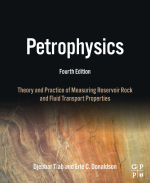Добрый день, Коллеги. Важное сообщение, просьба принять участие. Музей Ферсмана ищет помощь для реставрационных работ в помещении. Подробности по ссылке
Petrophysics theory and practice of measuring reservoir rock and fluid transport properties / Петрофизика, теория и практика измерения свойств пород-коллекторов и транспорта флюидов
Petrophysics is the study of rock properties and their interactions with fluids (gases, liquid hydrocarbons, and aqueous solutions). The geologic material forming a reservoir for the accumulation of hydrocarbons in the subsurface must contain a three-dimensional network of interconnected pores in order to store the fluids and allow for their movement within the reservoir. Thus, the porosity of the reservoir rocks and their permeability are the most fundamental physical properties with respect to the storage and transmission of fluids. Accurate knowledge of these two properties for any hydrocarbon reservoir, together with the fluid properties, is required for efficient development, management and prediction of future performance of the oilfield.
The purpose of this text is to provide a basic understanding of the physical properties of porous geologic materials, and the interactions of various fluids with the interstitial surfaces and the distribution of pores of various sizes within the porous medium. Procedures for the measurement of petrophysical properties are included as a necessary part of this text. Applications of the fundamental properties to subsurface geologic strata must be made by analyses of the variations of petrophysical properties in the subsurface reservoir.
Emphasis is placed on the testing of small samples of rocks to uncover their physical properties and their interactions with various fluids. A considerable body of knowledge of rocks and their fluid flow properties has been obtained from studies of artificial systems such as networks of pores etched on glass plates, packed columns of glass beads, and from outcrop samples of unconsolidated sands, sandstones, and limestones. These studies have been used to develop an understanding of the petrophysical and fluid transport properties of the more complex subsurface samples of rocks associated with petroleum reservoirs. This body of experimental data and production analyses of artificial systems, surface and subsurface rocks make up the accumulated knowledge of petrophysics. Although the emphasis of this text is placed on the analyses of small samples, the data are correlated to the macroscopic performance of the petroleum reservoirs whenever applicable. In considering a reservoir as a whole, one is confronted with the problem of the distribution of these properties within the reservoir and its stratigraphy. The directional distribution of thickness, porosity, permeability, and geologic features that contribute to heterogeneity governs the natural patter of fluid flow. Knowledge of this natural pattern is sought to design the most efficient injection-production system for economy of energy and maximization of hydrocarbon production [1]. <...>




